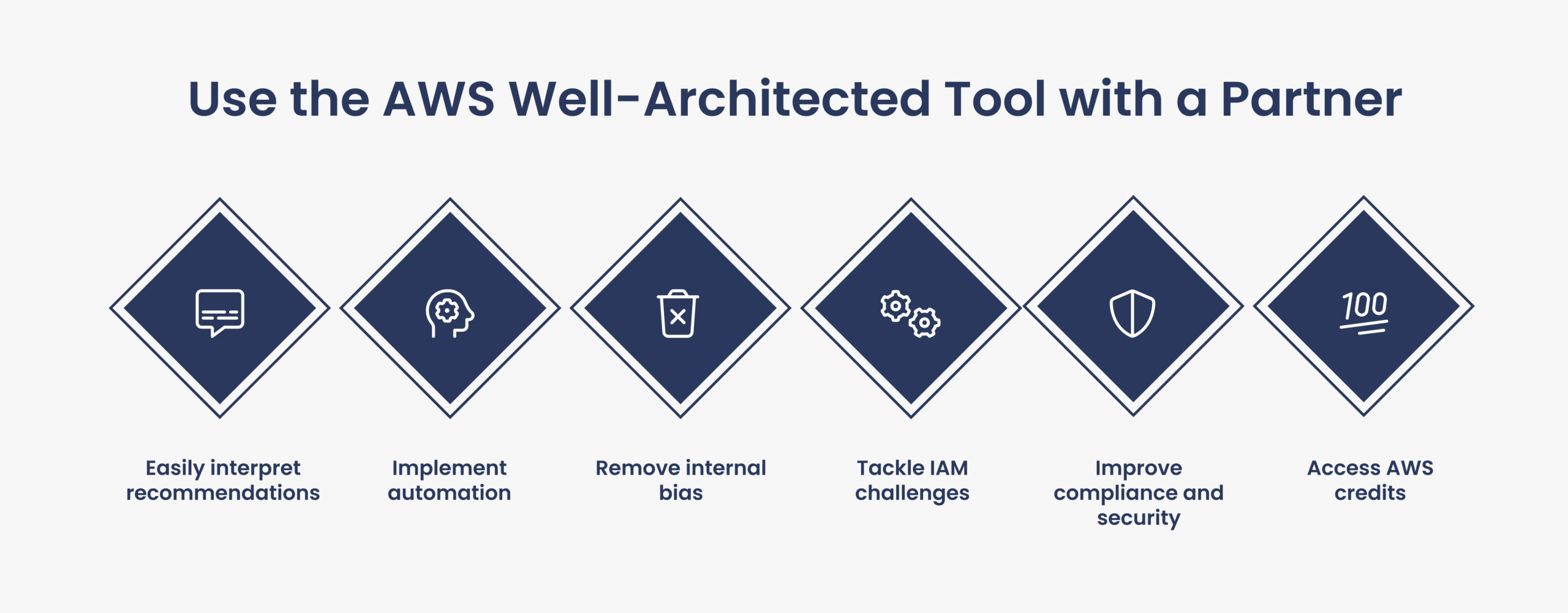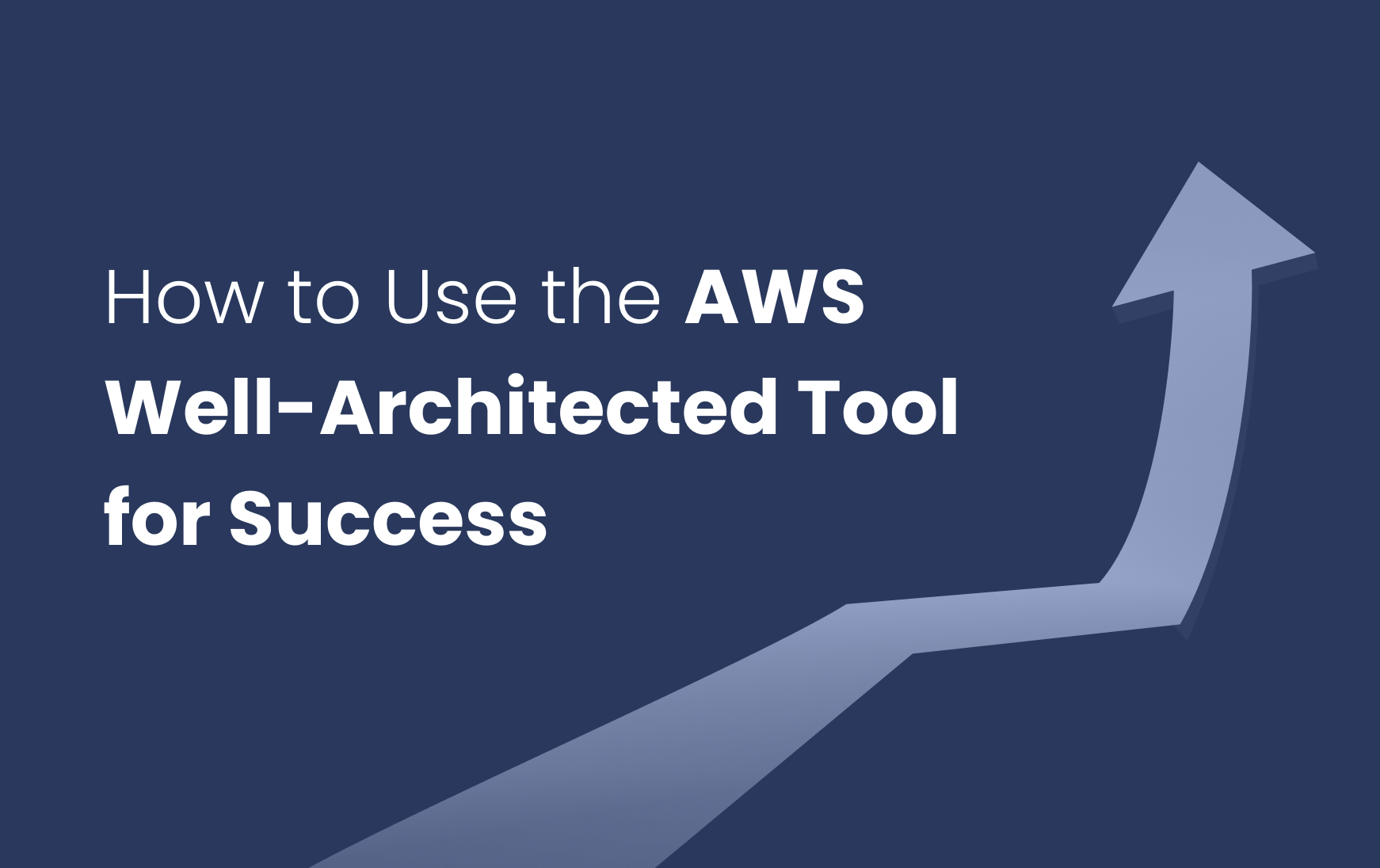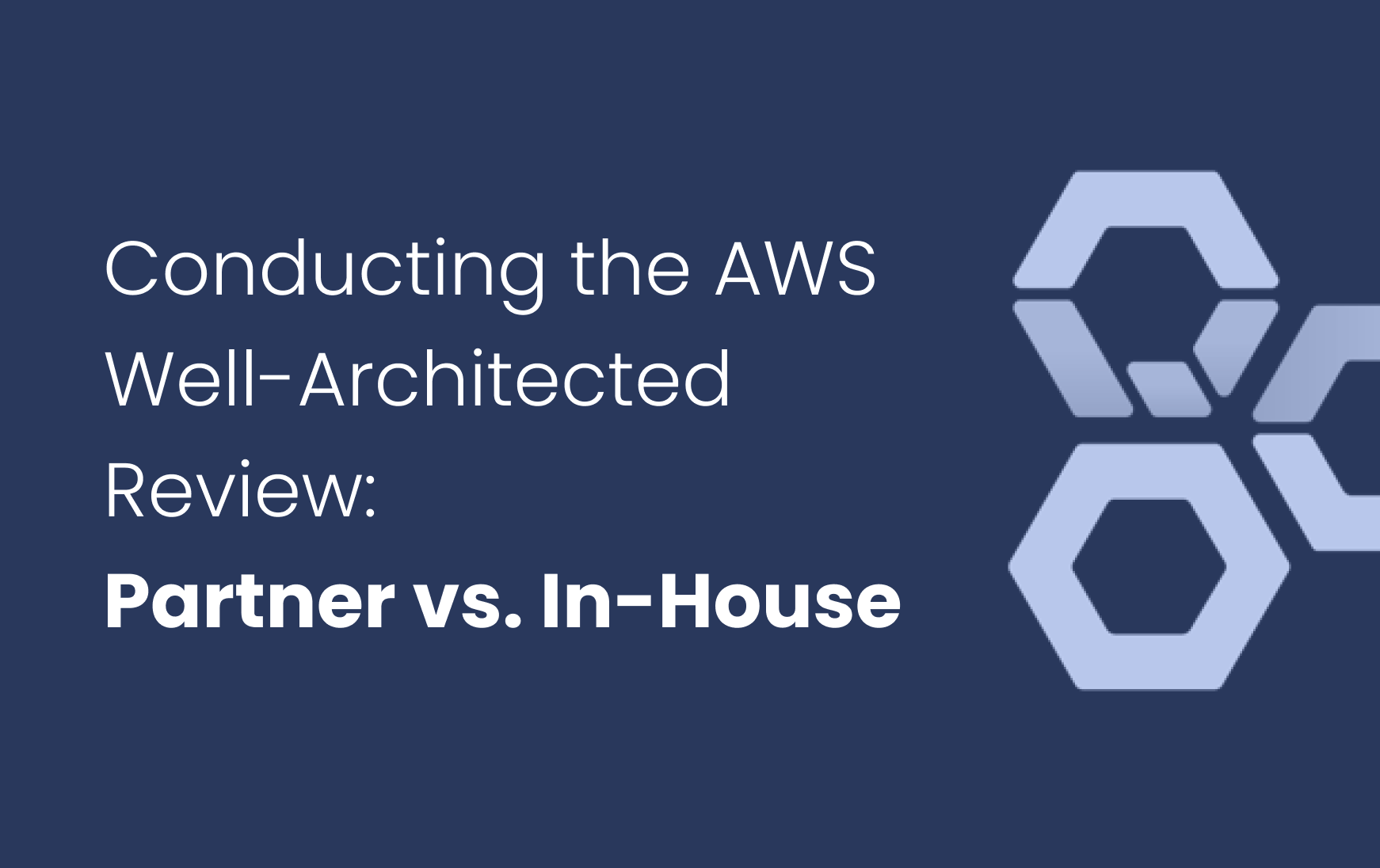How to Use the AWS Well-Architected Tool for Success
What defines the success of your AWS Well-Architected Framework Review? It is how well you use the AWS Well-Architected Tool to detect critical risks and optimization opportunities. When you fail to use the AWS Well-Architected Tool effectively, you get fragmented insights and missed opportunities.
Here is what a presenter said during a Well-Architected Framework session at AWS re:Invent.
Ensure you have the right people in the room to do your AWS Well-Architected Framework Review—people who can make big decisions and implement change.
While the AWS Well-Architected Tool is a self-service platform, organizations often face navigation challenges without the right AWS expertise. To use the AWS Well-Architected Tool successfully, organizations must interpret complex technical questions, implement fixes, and continuously reassess workloads.
In this blog, we examine the emergence of the AWS Well-Architected Tool and its key features. We also discuss how to use the AWS Well-Architected Tool successfully and how poor use can lead to failure.
What is the AWS Well-Architected Tool?
Are you struggling to navigate the AWS Well-Architected Tool, prioritize issues, and implement remediations? A lack of structured approach, limited expertise, and complexity of cloud best practices implementation could be at fault.
The AWS Well-Architected Tool is a digital service for measuring cloud architecture against the AWS Well-Architected pillars. It assists organizations in the following areas.
- Document decisions based on AWS Well-Architected Framework Review and standard best practices.
- Make recommendations for improving cloud workloads.
- Create custom lenses to meet governance needs specific to your organization.
In 2012, AWS had a cloud outage that deeply impacted some clients. However, another section of clients went ahead with business as usual. When AWS enquired about the matter, they realized that the outage did not affect clients who followed a set of best practices.
AWS started assembling a series of best practices to ensure optimum cloud health, and the AWS Well-Architected Framework was born. The AWS Well-Architected Framework is based on six pillars: operational excellence, security, reliability, performance efficiency, cost optimization, and sustainability.
-
- Operational excellence: Ensures your cloud workloads run at peak health through continuous monitoring, actionable insights, safe automation, and failure anticipation.
- Security: Protects data, systems, and assets through identity management, traceability, and incident response.
- Reliability: Builds architectures that can handle scalability, recover automatically from failure, and design recovery procedures through simulation.
- Performance efficiency: Uses cloud resources efficiently while using the latest technologies that deliver high performance at low cost.
- Cost Optimization: Improves cloud capacity planning to avoid using idle or expensive resources.
- Sustainability: Focuses on environmental impacts, efficient hardware and software, managed services, and reducing energy consumption.
In 2018, AWS launched the Well-Architected Tool to help customers access, improve, and implement the AWS Well-Architected Framework Review.
6 Ways to Use the AWS Well-Architected Tool for Success
Organizations must follow a structured approach to use the AWS Well-Architected Tool successfully. This approach starts with defining the business objective, understanding the AWS Well-Architected Framework, adding lenses, and more. Here is a high-level guide.
1. Workload review and improvement: Start by defining and documenting a workload by answering questions across the six pillars of the AWS Well-Architected Framework Review. After completing the documentation, the AWS Well-Architected Tool generates a workload report highlighting issues per pillar and an improvement plan.
2. Add a lens: AWS Well-Architected Lenses extend guidance on specific technologies such as SaaS, data analytics, IoT, and machine learning. Organizations can add up to twenty lenses to a workload. The AWS Well-Architected Tool also offers custom lenses where users can tailor questions for a particular technology.
3. Activate AWS Trusted Advisor: The AWS Well-Architected Tool integrates with AWS Trusted Advisor to improve workload reliability, security, and cost optimization. However, to view Trusted Advisor information, associated account owners on the workload must go to IAM and create a role.
4. Create review templates: Use the AWS Well-Architected Tool to create review templates. These templates reduce the need to fill out repeatable answers and standardize manual processes.
5. Encourage collaboration: To successfully use the AWS Well-Architected Tool, include security and operations team members to obtain accurate data and align with best organizational practices.
6. Regular reviews: Use the AWS Well-Architected Tool to conduct reviews regularly, for example, every quarter, to keep up with cloud, security, and compliance changes.
Use the AWS Well-Architected Tool with Partner Engagement
The AWS Well-Architected Tool is a powerful service for cloud insights and assessment. However, when you use the AWS Well-Architected Tool without AWS expertise, it can be challenging. Here is how you can benefit from an AWS partner and their hands-on AWS Well-Architected Tool guidance.

Advantages of an AWS Well-Architected Partner for AWS Well-Architected Tool navigation.
1. Easily interpret recommendations
The AWS Well-Architected Tool facilitates access to cloud workflow best practices. However, organizations must interpret recommendations and risks and prioritize fixes. In-house teams may lack certified AWS solution architects who can remediate high-risk issues without disrupting workloads.
2. Implement automation
The AWS Well-Architected Tool identifies gaps but does not fix them. Organizations must manually fix security and performance inefficiencies. An AWS partner brings knowledge of AWS services like Config and Security Hub to help remediate and monitor changes.
3. Remove internal bias
The AWS Well-Architected Tool uses manual questionnaire responses, which, if conducted in-house, may lead to subjectivity in risk assessments. Without external benchmarking, teams may underestimate or overestimate risks.
4. Tackle IAM challenges
Organizations must configure security requirements and IAM permissions to use the AWS Well-Architected Tool across multiple AWS accounts. Partners offer the right technical expertise to ensure cross-account visibility.
5. Improve compliance and security
The AWS Well-Architected Tool highlights security and compliance best practices, but validating SOC 2 and HIPAA requires additional expertise. In-house teams may lack knowledge of continuous compliance requirements.
6. Access AWS credits
Get access to partner credits to fix high-risk issues that are only available to AWS Partners. With in-house teams, you may lose the opportunity to leverage cost savings opportunities.
Here is a quick comparison of using the AWS Well-Architected Tool in-house versus partnering with an AWS expert.
Use the AWS Well-Architected Tool for Success: A Comparative Analysis
| Standards | In-house team | AWS Partner |
| AWS knowledge | Limited | Certified AWS Architects |
| Risk interpretation | Subjective | Industry benchmarks |
| Remediation | Manual | Automated and scalable |
| AWS credits | nil | Eligible for AWS credits |
| Continuous monitoring | Inconsistent | Regular |
| WAFR experience | Limited | Multiple projects |
Poor Use of the AWS Well-Architected Tool: Setbacks
Poor use of the AWS Well-Architected Tool can cause several setbacks, such as repeated misconfigurations, misinterpreted best practices, a lack of high-risk issue remediation, and security vulnerabilities.
- Incomplete assessments
- Inexperienced teams that rush through the AWS Well-Architected Tool or offer vague responses miss critical insights.
- Failure to include key stakeholders results in unstructured data and improper recommendations.
- Ignoring high-risk issues
- Many organizations fail to remediate high-risk issues on time as they lack resources or prioritization.
- Unresolved high-risk issues lead to security breaches, downtime, or unexpected costs.
- Not revisiting the tool regularly
- The AWS Well-Architected Tool is not a one-time exercise. Workloads evolve, and new issues emerge.
- Without regular reviews, organizations lose sight of regular compliance and performance optimizations.
- Lack of actionable remediation
- Identifying risks is not enough; tailored action items must be implemented.
- Without executive buy-in, teams may struggle to allocate resources for remediation.
Conclusion: Use the AWS Well-Architected Tool with Partner-led Support
The AWS Well-Architected Framework Review and the AWS Well-Architected Tool are standardized ways to evaluate cloud workloads and implement best practices. However, to use the AWS Well-Architected Tool effectively takes practice, experience, and strong AWS knowledge.
To qualify for partner status, AWS Well-Architected Partners must undergo in-depth training and complete a minimum number of reviews on the AWS Well-Architected Tool. They also help clients bridge gaps in AWS Well-Architected pillars through effective remediation and automation. AWS partners often use software solutions that integrate with the AWS Well-Architected Tool. These tools automate the discovery of architectural issues and provide actionable insights, streamlining the review process and facilitating efficient remediation.
Are you looking for an experienced AWS Well-Architected Partner who can help you use the AWS Well-Architected Tool and achieve tangible cloud improvements? Contact Ibexlabs today.
FAQs
Is the AWS Well-Architected Tool free?
Yes, the AWS Well-Architected Tool is free to use within the AWS Management Console.
However, even though it is free, organizations often struggle with interpreting results and implementing best practices. AWS Advanced and Premier partners can help businesses prioritize fixes, implement optimizations, and unlock AWS service credits for remediation.
What is the use of the AWS Well-Architected Tool?
The AWS Well-Architected Tool helps organizations assess their cloud workloads against the six key pillars of the AWS Well-Architected Framework: operational excellence, security, reliability, performance efficiency, cost optimization, and sustainability.
The tool identifies high-risk issues and recommends improvements in architecture, security, and efficiency.
Can I use the AWS Well-Architected Tool for SOC 2 compliance?
Yes, the AWS Well-Architected Tool helps with SOC 2 compliance by identifying security, reliability, and operational risks.
While it doesn’t provide a direct SOC 2 certification, it guides organizations in implementing AWS best practices that align with SOC 2 Trust Service Criteria, which makes compliance easier.
Does the AWS Well-Architected Tool generate an improvement report?
Yes, the AWS Well-Architected Tool generates an improvement report after a workload assessment, highlighting risks and best practices. The report categorizes issues as high-risk, medium-risk, or low-risk. Organizations can use this report to prioritize fixes and work with AWS partners to implement optimizations.
What are AWS Well-Architected Tool Lenses?
The AWS Well-Architected Tool Lenses is a specialized framework that provides industry-specific and technology-specific best practices for assessing workloads. AWS offers various lenses, such as serverless, SaaS, machine learning, and financial services, to help organizations evaluate workloads beyond the standard Well-Architected Framework. These lenses provide customized guidance to address unique challenges and optimize workloads for specific use cases.









